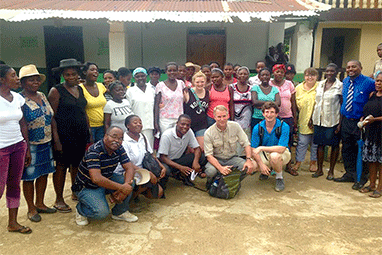SPARTANBURG, S.C. – Microfinance works, and Wofford senior Nancy Ford developed an evidence-based magazine to prove it. The magazine is the culmination of her capstone project on microfinance in Latin America and the Caribbean.
A double major in intercultural studies and finance from Sylva, N.C., Ford visited Haiti, the Dominican Republic and Nicaragua to observe successful and unsuccessful microfinance initiatives as part of her research.
Ford also is completing Wofford's Latin American and Caribbean Studies program, and her capstone research was directed by Dr. Laura Barbas Rhoden, professor in the Department of Modern Languages, Literatures and Cultures.
Ford's adviser, Dr. Philip Swicegood, the R. Michael James Professor of Finance and chair of the department at Wofford, introduced her to the concept of microfinance just over a year ago with an invitation to accompany representatives from the James Fund to Haiti to monitor the group's investments. The James Fund, a student-managed investment fund at the college, was founded in 2009 with a donation from Wofford Trustee Mike James, Wofford Class of 1973. After three years the James Fund was successful enough to begin using the profits of its investments to award microfinance loans in northern Haiti. The amounts vary from region to region, but typically average about $300 per loan with a 2 percent interest rate per month. Part of the interest earned from the loans is put into savings accounts on behalf of the borrowers and returned to them at the end of the year. Another part is put into savings accounts on behalf of the entire community, and returned every three years.
“It’s their money,” Swicegood says. “It’s not a gift from us or a handout …. We want to encourage self-sustaining dignity and a reward for good, hard work.”
This concept of fostering of self-sustaining dignity is what attracted Ford to microfinance.
“These loans seemed to be increasing the capacity of the poor,” Ford says. “It’s done by the poor and for the poor, to uplift them out of their own poverty. It gives them the capability to believe in themselves, and to help them realize they do have God-given skills, personalities and abilities to make something of their lives.”
Muhammed Yunus, Nobel Prize winner and “Father of Microfinance,” defines the practice of microfinance as “lending small amounts of money at low interest rates to individuals, families and groups in the developing world.” Ford cites this definition in her magazine, along with a real-world example she saw in Nicaragua.
“Pamela lives with six children and no husband. She went to a local moneylender, known as a loan shark, and borrowed money at a large interest rate. She went to another moneylender to pay off the second loan, and another to pay off the third. She ended up in an overwhelming debt trap,” Ford says. “Pamela fled to the capital city and was able to start over. Through a relative, she heard of a restaurant that was running off of a loan from a microfinance institution (MFI). She went to the MFI the next to day, and borrowed $200 at a 4 percent interest rate.”
These loans are often structured into group loans, so that if one member falls behind for a month, the others can pick up the slack. In the magazine, Ford says that the community-centric, family-oriented culture in Latin America and the Caribbean is conducive to this type of loan.
“The group loan brought Pamela into a business community and helped her thrive economically,” Ford says. “This isn’t an uncommon concept in impoverished communities. You see people selling things from roadside stands or washing windshields for money. Microfinance complements the cultural realities that already exist.”
However, it is not a perfect system. According to Ford, MFIs face a number of challenges: lack of business education, lack of business savvy or strategizing skills, lack of self discipline with money, unforeseen weather events or forgiveness of debt by MFIs, which undermine the foundation of trust that microfinance is built on.
“It can’t be the ultimate solution for all nations,” Ford says. “The system is built on a foundation of trust from a two-way exchange. This exchange would collapse if the recipient of the loan becomes lax about making payments. They wouldn’t be taken seriously, nor would they take their organization seriously. If other recipients hear about this, they would no longer trust the system.”
Despite these challenges, successful models of microfinance do exist.
In her magazine Ford writes, “Microfinance as a whole often promotes teamwork and improves economic statuses of communities. Financially, most MFIs have repayment rates between 90 and 100 percent. Additionally, because MFIs work with such small amounts of capital, a defaulting borrower will not bring down a sufficiently funded system or institution.”
By Katie Sanders, Wofford Class of 2017
